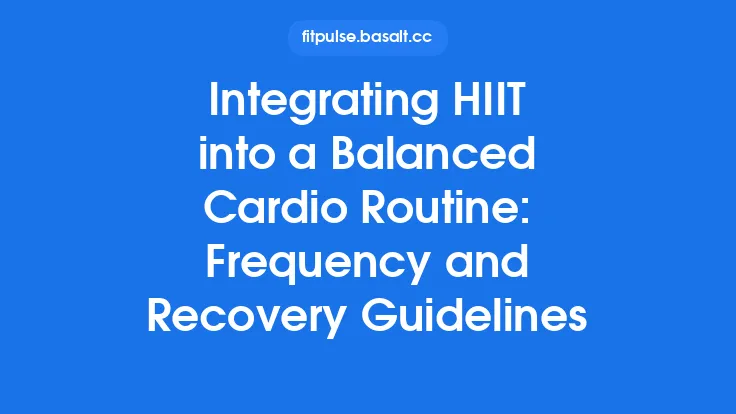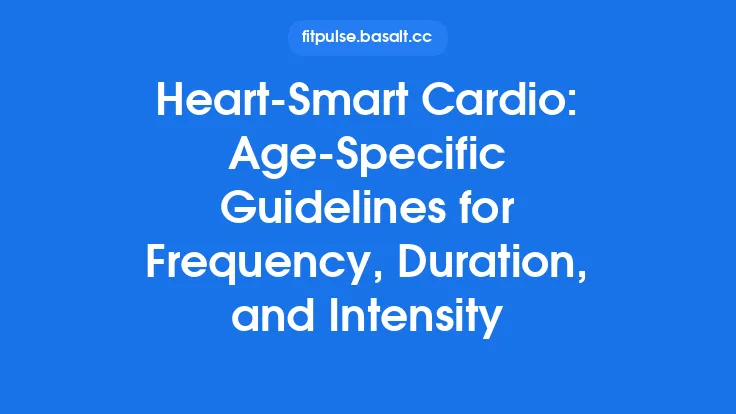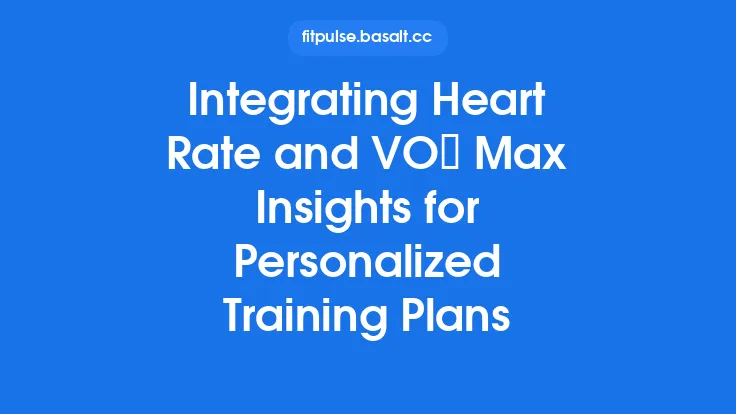Integrating heart‑rate data with perceived exertion creates a more nuanced picture of cardiovascular stress than either metric can provide on its own. By weaving together the objective pulse count and the subjective sense of effort, coaches and athletes can craft cardio programs that respect individual variability, promote steady progression, and reduce the risk of over‑training. This approach is especially valuable in today’s fitness landscape, where wearable technology supplies continuous heart‑rate streams while the human body still relies on internal cues to signal fatigue, readiness, and adaptation.
Why Combine Objective and Subjective Metrics?
Complementary Perspectives
Heart‑rate (HR) offers a quantifiable snapshot of cardiovascular load at any given moment, reflecting the immediate demand placed on the heart and circulatory system. Perceived exertion, on the other hand, captures the athlete’s internal assessment of difficulty, integrating factors that HR alone cannot—muscle fatigue, breathing patterns, mental stress, ambient temperature, and even hydration status. When both signals align, confidence in the training intensity is high; when they diverge, the discrepancy itself becomes a diagnostic cue.
Individual Variability
Two athletes with identical HR zones may experience vastly different levels of effort due to genetics, training history, or day‑to‑day physiological fluctuations. By pairing HR with a simple effort rating, the program automatically adjusts for these personal differences without requiring complex laboratory testing.
Safety Net for Anomalies
Occasionally, HR readings can be skewed by technical glitches, medication, or cardiac irregularities. A concurrent exertion rating can flag when the heart‑rate data may be misleading, prompting a quick reassessment before the athlete pushes beyond safe limits.
Core Principles of Integrated Cardio Programming
- Dual‑Input Baseline Establishment
- Objective Baseline: Record resting HR, typical HR response to a moderate jog, and a short, high‑intensity burst. This creates a personal reference frame without needing a formal maximal test.
- Subjective Baseline: Have the athlete rate the perceived difficulty of those same efforts on a simple 0‑10 scale (0 = no effort, 10 = maximal). Over several sessions, patterns emerge that define the athlete’s “normal” effort‑HR relationship.
- Relative Scaling Over Absolute Numbers
Instead of prescribing a fixed HR number (e.g., 150 bpm), define intensity as a percentage of the individual’s observed HR range for a given effort level. Pair this with a target exertion band (e.g., 5‑6/10). This relative scaling respects day‑to‑day fluctuations.
- Feedback Loop Integration
After each cardio segment, the athlete records both HR (average, peak) and exertion rating. The coach reviews the pair, noting alignment or drift. Adjustments for the next segment are then made based on this combined feedback.
- Progressive Overload with Dual Checks
Incremental increases in duration, volume, or speed are only approved when both HR and exertion remain within the pre‑set bands. If HR climbs disproportionately while exertion stays low, the load may be too aggressive; if exertion spikes while HR lags, fatigue may be accumulating.
Designing Sessions with Dual Feedback
| Session Element | HR Guidance (Relative) | Perceived Exertion Guidance |
|---|---|---|
| Warm‑up (5‑10 min) | 50‑60 % of personal HR range for light activity | 2‑3/10 |
| Base Cardio (20‑40 min) | 60‑70 % of HR range (steady‑state) | 4‑5/10 |
| Tempo Segment (5‑10 min) | 75‑85 % of HR range | 6‑7/10 |
| Interval Burst (30‑60 s) | 90‑95 % of HR range | 8‑9/10 |
| Cool‑down (5‑10 min) | 50‑55 % of HR range | 2‑3/10 |
Practical Flow
- Set the Intent: Decide whether the day focuses on endurance, threshold work, or high‑intensity intervals.
- Select Target Bands: Choose the HR percentage and exertion range that correspond to the intent.
- Monitor Continuously: Use a wearable or chest strap for HR, but pause every 5‑10 minutes to note the current exertion rating.
- Adjust on the Fly: If the exertion rating drifts outside the target band for two consecutive checks, modify speed, incline, or resistance to bring it back into alignment.
- Post‑Session Review: Plot HR vs. exertion over time. A tight clustering indicates stable training; widening spreads may signal fatigue or external stressors.
Progression Strategies Using Combined Data
1. Incremental Volume Expansion
- Rule of Thumb: Add no more than 10 % total weekly cardio time, but only if the average exertion for the added volume stays within the prescribed band.
- HR Check: Ensure the average HR for the new volume does not exceed the upper limit of the target range by more than 5 %.
2. Intensity Shifts via Tempo Manipulation
- Step‑Up Approach: Increase the tempo segment’s speed or incline by a small, measurable amount (e.g., 0.5 km/h or 1 % grade).
- Dual Confirmation: Verify that HR rises proportionally (≈5‑7 % of the HR range) and that exertion climbs by only one point on the 0‑10 scale.
3. Interval Density Adjustments
- Add a Repetition: Insert an extra 30‑second high‑intensity burst after the same recovery period.
- Monitor: If HR spikes dramatically (≥10 % above the interval target) while exertion remains low, the recovery may be insufficient; extend the rest interval.
4. Recovery‑Focused De‑Loads
- Deload Week: Reduce volume by 20‑30 % and keep intensity at the lower end of the HR range, aiming for exertion ratings of 2‑3/10 throughout.
- Purpose: Allows the autonomic nervous system to reset, which will be reflected in lower perceived effort for the same HR in subsequent weeks.
Tailoring Programs for Different Goals and Populations
| Goal / Population | Primary HR Emphasis | Primary Exertion Emphasis | Integration Tips |
|---|---|---|---|
| Weight Management | Moderate HR (60‑70 % range) for calorie burn | Light‑to‑moderate exertion (3‑5/10) to sustain longer sessions | Use longer steady‑state bouts; monitor exertion to avoid premature fatigue. |
| Endurance Athletes | Lower HR zones for long‑duration runs (50‑65 %) | Low exertion (2‑4/10) to promote aerobic adaptations | Periodically insert “effort spikes” (6‑7/10) while keeping HR modest to train efficiency. |
| HIIT Enthusiasts | High HR peaks (85‑95 %) | High exertion (7‑9/10) during bursts, low (2‑3/10) during recovery | Track the ratio of peak HR to recovery HR alongside exertion swings to gauge conditioning. |
| Older Adults / Rehab | Sub‑maximal HR (50‑60 %) | Very light exertion (1‑3/10) | Emphasize consistency; use exertion to detect early signs of over‑exertion even if HR stays low. |
| Team Sport Players | Variable HR depending on drill intensity | Moderate exertion (4‑6/10) for skill work, higher (7‑8/10) for conditioning drills | Align HR zones with specific sport‑specific movements; use exertion to fine‑tune drill pacing. |
Monitoring Recovery and Adjusting Load
Even with perfect day‑to‑day alignment, cumulative fatigue can creep in. The integrated approach offers two practical recovery gauges:
- Morning Exertion Check‑In
- Before the first workout, ask the athlete to rate overall readiness on a 0‑10 scale. A higher baseline exertion (e.g., 5‑6) suggests residual fatigue, prompting a lighter cardio load or a recovery‑focused session.
- HR‑Exertion Drift Analysis
- Over a week, plot the difference between expected HR (based on the target percentage) and actual HR for each session. A consistent upward drift while exertion remains stable may indicate cardiovascular strain; a downward drift with rising exertion hints at muscular or systemic fatigue.
When either signal flags a mismatch, the program can be adjusted by:
- Reducing session duration by 10‑20 %
- Lowering intensity band (both HR and exertion) for the next 2‑3 days
- Incorporating active recovery (easy cycling, walking) with HR kept below 55 % and exertion at 1‑2/10
Practical Tools and Techniques
- Simple Log Sheet
| Date | Activity | Avg HR | Peak HR | Exertion Rating | Notes |
|---|---|---|---|---|---|
| ... | ... | ... | ... | ... | ... |
A paper or digital log that captures both numbers side‑by‑side makes pattern recognition effortless.
- Dual‑Axis Graphs
Plot exertion on the Y‑axis and HR on the X‑axis for each interval. A tight diagonal line indicates good alignment; scatter suggests a need for adjustment.
- Smartphone Prompt Apps
Use a reminder app to ping the athlete every 5‑10 minutes to record exertion, ensuring the data isn’t forgotten mid‑session.
- Recovery Questionnaires
Short daily surveys (e.g., “How rested do you feel?” 1‑5) can be cross‑referenced with HR‑exertion trends to validate the integrated model.
Case Example: Building a Balanced Weekly Cardio Plan
Athlete Profile:
- 30‑year‑old recreational runner aiming to improve race pace while staying injury‑free.
- Resting HR: 58 bpm.
- Typical HR for a comfortable jog: 130 bpm (≈65 % of observed HR range).
- Exertion rating for that jog: 4/10.
Weekly Structure (5 Sessions):
| Day | Session Type | Target HR % | Target Exertion | Key Adjustments |
|---|---|---|---|---|
| Mon | Easy Run (45 min) | 60‑65 % | 3‑4/10 | Keep pace steady; if exertion >4, reduce speed. |
| Tue | Tempo Run (30 min) | 75‑80 % | 6‑7/10 | Increase pace until HR hits 80 % and exertion stabilizes at 6. |
| Wed | Rest or Light Cross‑Train | <55 % | 1‑2/10 | Optional bike or swim; monitor HR to stay low. |
| Thu | Interval Session (6 × 1 min) | 90‑95 % (bursts) / 60‑65 % (recovery) | 8‑9/10 (bursts) / 3‑4/10 (recovery) | Adjust rest length if HR does not drop to recovery band. |
| Fri | Long Run (70 min) | 65‑70 % | 4‑5/10 | Focus on consistent effort; if exertion spikes, add short walk breaks. |
| Sat | Active Recovery (30 min walk) | <55 % | 2‑3/10 | Use as a reset day; note any lingering high exertion. |
| Sun | Rest | — | — | Review log; look for HR‑exertion drift. |
Outcome After 6 Weeks:
- Average race pace improved by 7 %.
- No reported over‑use injuries.
- HR‑exertion plots showed tighter clustering, indicating improved cardio efficiency.
Ensuring Consistency and Accuracy
- Calibration Sessions: Once a month, perform a short “calibration” workout where the athlete deliberately targets a known HR range and records the corresponding exertion. This re‑aligns the subjective scale with any physiological changes (e.g., improved fitness, seasonal temperature shifts).
- Environmental Adjustments: Heat, altitude, and humidity can elevate HR for a given effort. In such conditions, rely more heavily on the exertion rating to prevent over‑loading.
- Device Validation: Even though the article avoids deep technical setup, a quick check—comparing the wearable’s HR reading against a manual pulse count for 30 seconds—helps confirm the device’s reliability before each training block.
- Mindful Rating: Encourage athletes to rate exertion based on the whole‑body feeling, not just breathlessness. This holistic view captures muscular fatigue and mental stress, which HR alone may miss.
Looking Ahead: The Future of Integrated Cardio Monitoring
As sensor technology advances, we can expect richer data streams (e.g., continuous oxygen saturation, skin temperature) that will further inform the perceived‑effort model. Machine‑learning algorithms may soon auto‑detect mismatches between HR and exertion, offering real‑time coaching cues. However, the core principle remains timeless: pairing the measurable pulse with the athlete’s internal voice creates a resilient, adaptable framework for cardio programming that stands the test of time. By consistently applying this dual‑feedback loop, coaches and exercisers alike can navigate the fine line between challenge and overload, fostering steady progress while safeguarding health.





